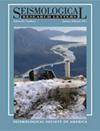Comparison of Ground-Shaking Hazard for Segmented versus Multifault Earthquake-Rupture Models in Aotearoa New Zealand
IF 3.2
3区 地球科学
Q2 GEOCHEMISTRY & GEOPHYSICS
引用次数: 0
Abstract
Multifault ruptures are common for historical earthquakes, and here we consider their impact on seismic hazard. We compare ground-shaking hazard forecasts from the 2022 Aotearoa New Zealand National Seismic Hazard Model (NZ NSHM 2022), which incorporates many multifault ruptures (referred to as the multifault model) with modeled hazard from a simpler model of characteristic earthquakes on individual faults or fault segments (referred to as the segmented model). The multifault model includes very-low-probability rupture lengths of up to ∼1100 km and a mean of 221–234 km, whereas the segmented model primarily comprises rupture lengths of <200 km (mean, 43–51 km) and the maximum of 414 km. The annual rates of Mw 6.9–7.5 earthquakes are more than an order of magnitude higher for the segmented model (0.132–0.24/yr; recurrence times ∼4–7 yr) than the multifault model (0.027/yr; recurrence times 37 yr). Conversely, the rates of earthquakes are similar for segmented and multifault models at Mw>7.5 (0.018–0.031/yr; recurrence times 32–56 yr). Despite differences in rupture lengths and annual rates of earthquakes, the calculated ground-shaking hazard at 10% probability of exceedance (PoE) in 50 yr for the segmented model differs by <55% compared with the multifault model for 95% of sites across Aotearoa New Zealand. For 50% of sites, the modeled hazard differs by <20% between the two models. If a distributed seismicity model (DSM) is included in the hazard calculations, 95% of sites differ in modeled hazard by <18%, and 50% of sites differ by <2.2%. In most areas, seismic hazard at 10% PoE in 50 yr is greater for the segmented model than the multifault model, with notable exceptions along the central Alpine fault in the western South Island and the Taupō volcanic zone in the central North Island.新西兰奥特雷地区分段地震破裂模型与多断层地震破裂模型的地震动危害比较
多断层破裂在历史上的地震中很常见,在此我们考虑它们对地震灾害的影响。我们比较了 2022 年新西兰奥特亚罗瓦国家地震危险性模型(NZ NSHM 2022)的地震动危险性预测(该模型包含许多多断层破裂(称为多断层模型))和单个断层或断层段上特征地震的简单模型(称为分段模型)的危险性模型。多断层模型包括长达 ∼1100 千米的极低概率断裂长度和 221-234 千米的平均断裂长度,而分段模型主要包括 7.5(0.018-0.031/年;重现时间 32-56 年)的断裂长度。尽管断裂长度和地震年发生率不同,但在新西兰奥特亚罗瓦 95% 的地点,分段模型计算出的 50 年内 10%超限概率(PoE)的地震动危险与多断层模型相比,相差小于 55%。在 50%的地点,两种模型的模拟危险度相差小于 20%。如果将分布式地震模型(DSM)纳入危险性计算,95% 的地点的模型危险性差异小于 18%,50% 的地点差异小于 2.2%。在大多数地区,50 年内 10% PoE 的地震危害在分段模型中要大于多断层模型,但南岛西部阿尔卑斯山脉中央断层和北岛中部陶波火山带明显例外。
本文章由计算机程序翻译,如有差异,请以英文原文为准。
求助全文
约1分钟内获得全文
求助全文
来源期刊

Seismological Research Letters
地学-地球化学与地球物理
CiteScore
6.60
自引率
12.10%
发文量
239
审稿时长
3 months
期刊介绍:
Information not localized
 求助内容:
求助内容: 应助结果提醒方式:
应助结果提醒方式:


